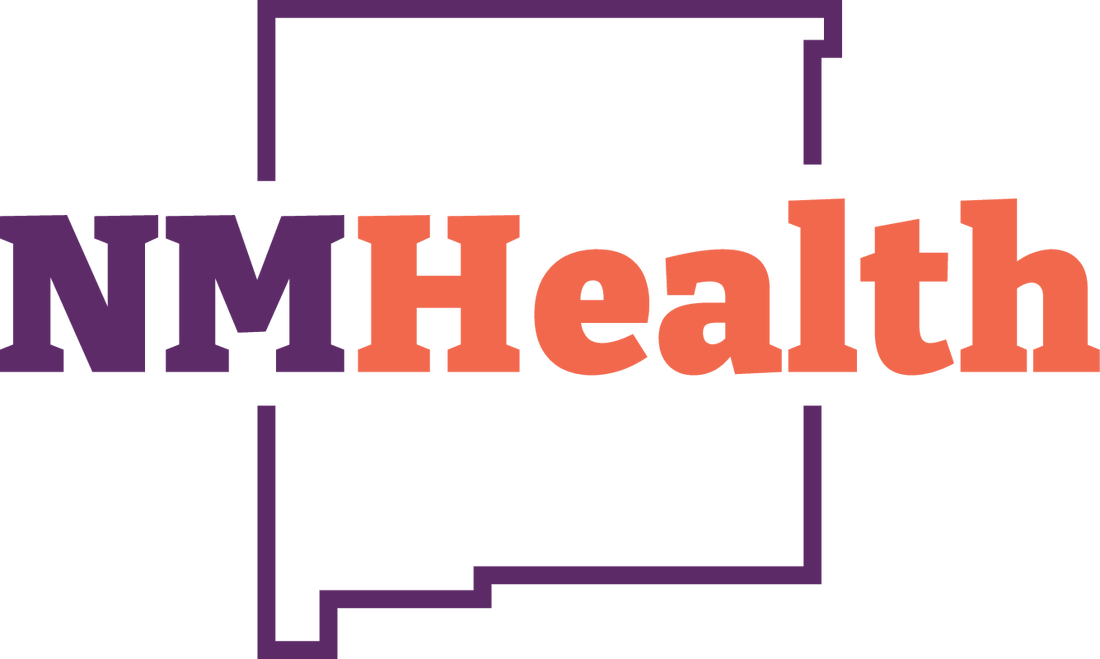Keyword Search
Here you can search the content of our website for any combination of keywords. Our custom search engine will perform a search using all of the text you enter, returning results which contain any of the keywords.
You can also fine-tune your searches by using operators. You can indicate that a keyword MUST be present by adding a plus symbol in front of the term. You may also indicate that a keyword must NOT be present by using a minus symbol prefix in front of the term.
EXAMPLE: Immunization +Schedule -Drug -Fee -CHW -Payroll
Please see our Guide to Using Search Engine Operators to learn more about the search engine operators you can use.
53 matches found for “HIV”.
-
HIV Surveillance & Epidemiology (topic)
-
HIV Services Program (topic)
-
National Native Americans HIV/AIDS Awareness Day (news)
[+]
March 18, 2015 — National Native American HIV/AIDS Awareness Day is being observed in New Mexico and across the nation on Friday, March 20th. The goal of the day is to raise awareness about the impact that HIV/AIDS has on American Indians, Alaska Natives, and Native Hawaiians and to honor those who are infected or a...
-
Effects of Varying Concentrations of Bleach on in vitro HIV-1 Replication & Relevance to Injection Drug Use (publication)
[+]
 The use of bleach as a disinfectant for drug injection equipment in the intravenous-drug-using population was recommended early in the HIV-1/AIDS epidemic. Epidemiological studies have challenged the use of bleach as an effective measure to prevent HIV-1 transmission.
The use of bleach as a disinfectant for drug injection equipment in the intravenous-drug-using population was recommended early in the HIV-1/AIDS epidemic. Epidemiological studies have challenged the use of bleach as an effective measure to prevent HIV-1 transmission.
-
HIV/AIDS Risk Ascertainment and “No Identified Risk” (health data)
[+]
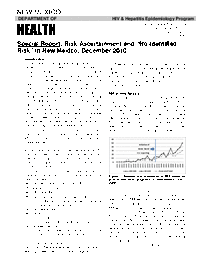 Determining the most likely source of HIV infection is an essential function of HIV surveillance programs. Risk factors for HIV infection are used to monitor the emergence of new or unusual transmission routes, monitor trends in transmission, target risk reduction interventions to the most affected groups, evaluate HIV programs, and allocate HIV prevention resources.
Determining the most likely source of HIV infection is an essential function of HIV surveillance programs. Risk factors for HIV infection are used to monitor the emergence of new or unusual transmission routes, monitor trends in transmission, target risk reduction interventions to the most affected groups, evaluate HIV programs, and allocate HIV prevention resources.
-
HIV/AIDS Basic Science (resource)
[+]
 HIV stands for human immunodeficiency virus. It is the virus that can lead to acquired immunodeficiency syndrome, or AIDS. Unlike some other viruses, the human body cannot get rid of HIV. That means that once you have HIV, you have it for life.
HIV stands for human immunodeficiency virus. It is the virus that can lead to acquired immunodeficiency syndrome, or AIDS. Unlike some other viruses, the human body cannot get rid of HIV. That means that once you have HIV, you have it for life.
-
HIV/STD/Hepatitis Resource Guide (resource)
[+]
 Community-based website offering resources and information about HIV, STDs, Viral Hepatitis, and Harm Reduction services across New Mexico. This searchable guide will help you find the best and most appropriate services in your area.
Community-based website offering resources and information about HIV, STDs, Viral Hepatitis, and Harm Reduction services across New Mexico. This searchable guide will help you find the best and most appropriate services in your area.
-
HIV/AIDS Basic Statistics (resource)
[+]
 HIV and AIDS remain a persistent problem for the United States and countries around the world. While great progress has been made in preventing and treating HIV, there is still much to do. The questions in this section provide a broad overview of the effects of HIV and AIDS in the United States and globally.
HIV and AIDS remain a persistent problem for the United States and countries around the world. While great progress has been made in preventing and treating HIV, there is still much to do. The questions in this section provide a broad overview of the effects of HIV and AIDS in the United States and globally.
-
Health Department commemorates World AIDS Day; endorses Undetectable = Untransmittable (U=U) message (news)
[+]
December 5, 2019 — The New Mexico Department of Health (NMDOH) will be participating in two commemorations this week related to World AIDS Day, a day of remembrance of those lost to the HIV epidemic. The following events, sponsored by partner organizations in Albuquerque and Santa Fe, will bring together communities i...
-
National Black HIV/AIDS Awareness Day (news)
[+]
February 5, 2015 — The New Mexico Department of Health is proud to partner this year with multiple government agencies, including the Office of African American Affairs, advocacy groups and other organizations to promote “Two Seven”: National Black HIV/AIDS Awareness Day. A variety of educational events are takin...
-
HIV/AIDS End-of-Year Annual Surveillance Report - 2014 (health data)
[+]
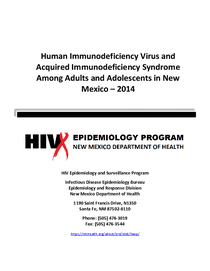 The 2014 HIV Surveillance Report includes data for adults and adolescents (aged 13 years and older at diagnosis) diagnosed with HIV infection in New Mexico, and/or living with HIV in New Mexico, through year-end 2013 based on reports of HIV infection submitted to the Program prior to Jan 1, 2015.
The 2014 HIV Surveillance Report includes data for adults and adolescents (aged 13 years and older at diagnosis) diagnosed with HIV infection in New Mexico, and/or living with HIV in New Mexico, through year-end 2013 based on reports of HIV infection submitted to the Program prior to Jan 1, 2015.
-
HIV/AIDS Concurrent Diagnoses in New Mexico (health data)
[+]
 The HIV/AIDS Epidemiology Program in New Mexico conducts confidential name-based HIV/AIDS reporting and subsequent epidemiological analyses. The HIV surveillance case definition includes a positive screening test result (e.g., reactive EIA) confirmed by a positive result from a supplemental HIV antibody test (e.g., Western Blot).
The HIV/AIDS Epidemiology Program in New Mexico conducts confidential name-based HIV/AIDS reporting and subsequent epidemiological analyses. The HIV surveillance case definition includes a positive screening test result (e.g., reactive EIA) confirmed by a positive result from a supplemental HIV antibody test (e.g., Western Blot).
-
HIV/AIDS End-of-Year Annual Surveillance Report - 2012 (health data)
[+]
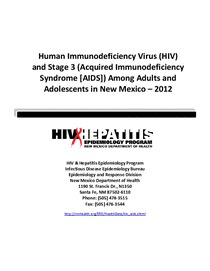 The 2012 HIV Surveillance Report includes data for adults and adolescents (aged 13 years and older at diagnosis) diagnosed with HIV infection in New Mexico, and/or living with HIV in New Mexico, through year-end 2012 based on reports of HIV infection submitted to the Program prior to July 1, 2013.
The 2012 HIV Surveillance Report includes data for adults and adolescents (aged 13 years and older at diagnosis) diagnosed with HIV infection in New Mexico, and/or living with HIV in New Mexico, through year-end 2012 based on reports of HIV infection submitted to the Program prior to July 1, 2013.
-
HIV/AIDS End-of-Year Annual Surveillance Report - 2011 (health data)
[+]
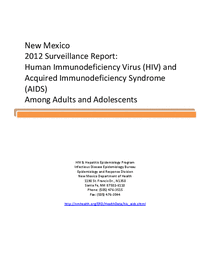 The 2011 HIV Surveillance Report includes data for adults and adolescents (aged 13 years and older at diagnosis) diagnosed with HIV infection in New Mexico, and/or living with HIV in New Mexico, through year-end 2012 based on reports of HIV infection submitted to the Program prior to July 1, 2012.
The 2011 HIV Surveillance Report includes data for adults and adolescents (aged 13 years and older at diagnosis) diagnosed with HIV infection in New Mexico, and/or living with HIV in New Mexico, through year-end 2012 based on reports of HIV infection submitted to the Program prior to July 1, 2012.
-
HIV/AIDS End-of-Year Annual Surveillance Report - 2013 (health data)
[+]
 The 2013 HIV Surveillance Report includes data for adults and adolescents (aged 13 years and older at diagnosis) diagnosed with HIV infection in New Mexico, and/or living with HIV in New Mexico, through year-end 2013 based on reports of HIV infection submitted to the Program prior to Jan 1, 2014.
The 2013 HIV Surveillance Report includes data for adults and adolescents (aged 13 years and older at diagnosis) diagnosed with HIV infection in New Mexico, and/or living with HIV in New Mexico, through year-end 2013 based on reports of HIV infection submitted to the Program prior to Jan 1, 2014.
-
HIV/AIDS End-of-Year Annual Surveillance Report - 2016 (health data)
[+]
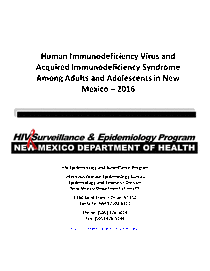 The 2014 HIV Surveillance Report includes data for adults and adolescents (aged 13 years and older at diagnosis) diagnosed with HIV infection in New Mexico, and/or living with HIV in New Mexico, through year-end 2013 based on reports of HIV infection submitted to the Program prior to Jan 1, 2015.
The 2014 HIV Surveillance Report includes data for adults and adolescents (aged 13 years and older at diagnosis) diagnosed with HIV infection in New Mexico, and/or living with HIV in New Mexico, through year-end 2013 based on reports of HIV infection submitted to the Program prior to Jan 1, 2015.
-
HIV/AIDS End-of-Year Annual Surveillance Report - 2015 (health data)
[+]
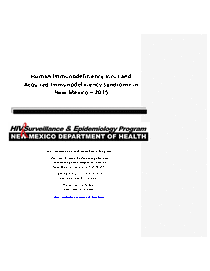 The 2014 HIV Surveillance Report includes data for adults and adolescents (aged 13 years and older at diagnosis) diagnosed with HIV infection in New Mexico, and/or living with HIV in New Mexico, through year-end 2013 based on reports of HIV infection submitted to the Program prior to Jan 1, 2015.
The 2014 HIV Surveillance Report includes data for adults and adolescents (aged 13 years and older at diagnosis) diagnosed with HIV infection in New Mexico, and/or living with HIV in New Mexico, through year-end 2013 based on reports of HIV infection submitted to the Program prior to Jan 1, 2015.
-
HIV Prevention (topic)
-
HIV/AIDS Fact Sheet for Hispanics (publication)
[+]
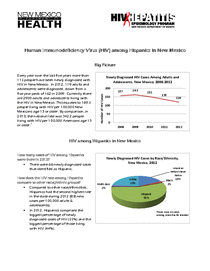 This helpful document provides a wealth of helpful facts about HIV/AIDS for Hispanics.
This helpful document provides a wealth of helpful facts about HIV/AIDS for Hispanics.
-
HIV/AIDS Confidential Case Reporting FAQ (publication)
[+]
 This helpful document provides answers to frequently asked questions about HIV/AIDS case reporting.
This helpful document provides answers to frequently asked questions about HIV/AIDS case reporting.
-
HIV/AIDS Access Recertification Form (publication)
[+]
 Use this form to recertify for the HIV/AIDS access program.
Use this form to recertify for the HIV/AIDS access program.
-
HIV/AIDS Confidential Case Reporting Form Instructions (publication)
[+]
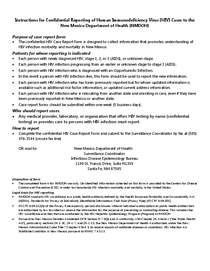 This helpful document explains how to complete the HIV/AIDS confidential case reporting form properly.
This helpful document explains how to complete the HIV/AIDS confidential case reporting form properly.
-
HIV/AIDS Fact Sheet for African Americans (publication)
[+]
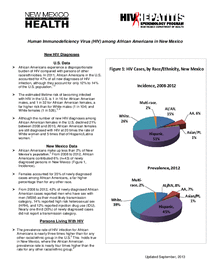 This helpful document provides a wealth of helpful facts about HIV/AIDS for African Americans.
This helpful document provides a wealth of helpful facts about HIV/AIDS for African Americans.
-
HIV/AIDS Fact Sheet for American Indians and Alaska Natives (publication)
[+]
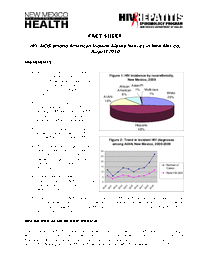 This helpful document provides a wealth of helpful facts about HIV/AIDS for American Indians and Alaska Natives.
This helpful document provides a wealth of helpful facts about HIV/AIDS for American Indians and Alaska Natives.
-
HIV Prevention and Care: New Mexico Integrated Plan 2017 – 2021 (publication)
[+]
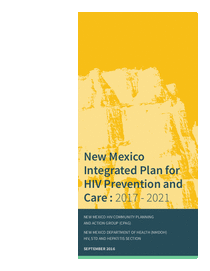 This document contains information such as NM Strengths and Weaknesses for Responding to HIV, confidential testing, statistics, and regional needs, gaps, and barriers.
This document contains information such as NM Strengths and Weaknesses for Responding to HIV, confidential testing, statistics, and regional needs, gaps, and barriers.
-
HIV/AIDS Confidential Case Reporting Form (publication)
[+]
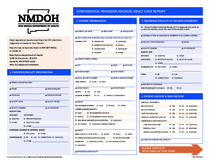 Use this form to confidentially report a case of HIV/AIDS.
Use this form to confidentially report a case of HIV/AIDS.
-
HIV Services Program Policies and Procedures (publication)
[+]
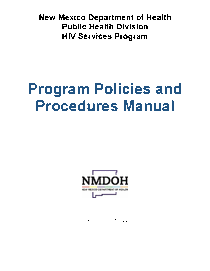 HIV Services Program Policies and Procedures
HIV Services Program Policies and Procedures
-
HIV/AIDS Fact Sheet for Women (publication)
[+]
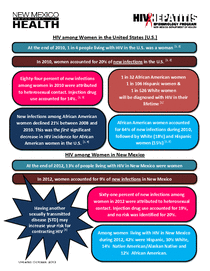 This helpful document provides a wealth of helpful facts about HIV/AIDS for Women.
This helpful document provides a wealth of helpful facts about HIV/AIDS for Women.
-
Client Handbook (Spanish) Guia de Atencion & Services del HIV (publication)
[+]
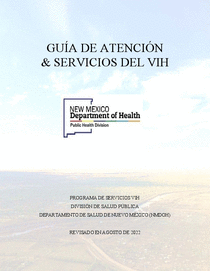 Client Handbook (Spanish) Guia de Atencion & Services del HIV
Client Handbook (Spanish) Guia de Atencion & Services del HIV
-
HIV Services Program Standards of Care (publication)
[+]
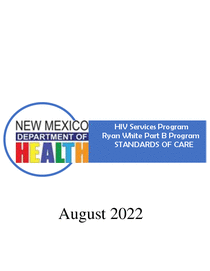 HIV Services Program Standards of Care
HIV Services Program Standards of Care
-
HIV Services Dental Program Fee Schedule FY24 (publication)
[+]
 This fee schedule will be updated on an annual basis to reflect the most current service payments for the HIV Services Dental Program.
This fee schedule will be updated on an annual basis to reflect the most current service payments for the HIV Services Dental Program.
-
New HIV infections associated with former VIP Spa in Albuquerque - June 26, 2023 (publication)
[+]
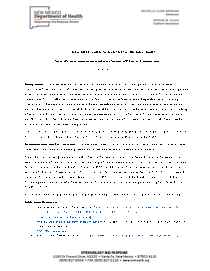 New HIV infections associated with former VIP Spa in Albuquerque - June 26, 2023
New HIV infections associated with former VIP Spa in Albuquerque - June 26, 2023
-
Integrated Plan for HIV Prevention and Care 2022-2026 (publication)
[+]
 Integrated Plan for HIV Prevention and Care 2022-2026
Integrated Plan for HIV Prevention and Care 2022-2026
-
Division of HIV/AIDS Prevention (resource)
[+]
 As a part of its overall public health mission, CDC provides leadership in helping control the HIV/AIDS epidemic by working with community, state, national, and international partners in surveillance, research, and prevention and evaluation activities. These activities are critically important because CDC estimates that about 1.2 million Americans are living with HIV, and that 12.8% of these persons do not know they are infected.
As a part of its overall public health mission, CDC provides leadership in helping control the HIV/AIDS epidemic by working with community, state, national, and international partners in surveillance, research, and prevention and evaluation activities. These activities are critically important because CDC estimates that about 1.2 million Americans are living with HIV, and that 12.8% of these persons do not know they are infected.
-
Prevention Access Campaign (resource)
[+]
 Prevention Access Campaign is a health equity initiative to end the dual epidemics of HIV and HIV-related stigma by empowering people with and vulnerable to HIV with accurate and meaningful information about their social, sexual, and reproductive health.
Prevention Access Campaign is a health equity initiative to end the dual epidemics of HIV and HIV-related stigma by empowering people with and vulnerable to HIV with accurate and meaningful information about their social, sexual, and reproductive health.
-
HIV Partner Services (health data)
[+]
 Partner Services for sexually transmitted diseases (STD) has been a component of public health practice in the United States since the early 1900’s. It began as contact tracing in the 1940’s in an effort to control and reduce syphilis infections. After the HIV epidemic began, HIV partner notification was often combined with STD contact tracing or some HIV programs used methods previously only applied to STD.
Partner Services for sexually transmitted diseases (STD) has been a component of public health practice in the United States since the early 1900’s. It began as contact tracing in the 1940’s in an effort to control and reduce syphilis infections. After the HIV epidemic began, HIV partner notification was often combined with STD contact tracing or some HIV programs used methods previously only applied to STD.
-
HIV/AIDS and Opportunistic Infections (health data)
[+]
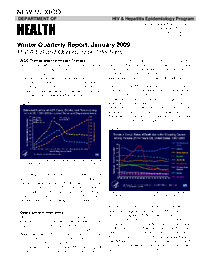 Since 1996 when the use of highly active antiretroviral therapy (HAART) began, the natural history and progression of HIV has changed dramatically. The incidence of AIDS and deaths due to HIV has decreased considerably throughout the U.S., while the number of people able to live with HIV has continued to increase steadily.
Since 1996 when the use of highly active antiretroviral therapy (HAART) began, the natural history and progression of HIV has changed dramatically. The incidence of AIDS and deaths due to HIV has decreased considerably throughout the U.S., while the number of people able to live with HIV has continued to increase steadily.
-
National Black HIV/AIDS Awareness Day (news)
[+]
February 5, 2014 — The New Mexico Department of Health is teaming up with the Office of African American Affairs, African American Health and Social Services, and other partners to promote "Two Seven" National Black HIV/AIDS Awareness Day, which is February 7th.
-
HIV Reporting @ 505-476-3515 (hotline)
[+]
An HIV epidemiologist is available between 8am & 5pm, Monday through Friday, to answer questions and accept HIV surveillance reports.
-
Community Planning and Action Group (resource)
[+]
 A group of people living with HIV/AIDS, community workers, activists and Department of Health employees that come together to plan how to prevent HIV infection in our communities.
A group of people living with HIV/AIDS, community workers, activists and Department of Health employees that come together to plan how to prevent HIV infection in our communities.
-
Online Version of the HIV Case Report Form for New Mexico (resource)
[+]
 Online Version of the HIV Case Report Form for New Mexico
Online Version of the HIV Case Report Form for New Mexico
-
New Stage-3 HIV Infections (Report 4) (resource)
[+]
 Within 12 months of new HIV diagnosis. Rate per 100,000 population by NM public health region. (Map)
Within 12 months of new HIV diagnosis. Rate per 100,000 population by NM public health region. (Map)
-
Infectious Disease Surveillance (topic)
-
HIV Risk Reduction in Injection Drug Users (publication)
[+]
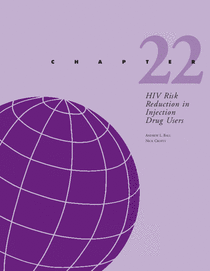 Infectious biomedical waste and sharps have a potential hazard of transmission of pathogens. Among sharps, used needles form a major share and disinfection by 1 % hypochlorite is recommended in biomedical waste management rules of India. The aim of the present study was to evaluate the efficacy of hypochlorite for the decontamination of needles.
Infectious biomedical waste and sharps have a potential hazard of transmission of pathogens. Among sharps, used needles form a major share and disinfection by 1 % hypochlorite is recommended in biomedical waste management rules of India. The aim of the present study was to evaluate the efficacy of hypochlorite for the decontamination of needles.
-
HIV/AIDS Prevention Program Overview (publication)
[+]
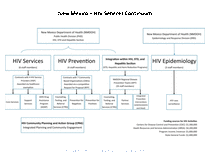 This document provides an overview of the funding sources, organization and activities of the program.
This document provides an overview of the funding sources, organization and activities of the program.
-
Appendix G – Part 3 – US MEC Update: Recommendations Among Women at Risk for HIV (publication)
[+]
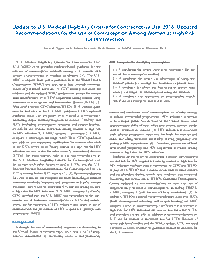 This is part of the family planning protocol document series.
This is part of the family planning protocol document series.
-
A Reason to See Red This Month (news)
[+]
December 4, 2013 — It’s December. Christmas is coming. ‘Tis the season and all that, but if there’s one color I wish we’d all see this holiday season. It’s red. Not just because of Santa but because of red ribbons and the message they represent to the thousands of people in New Mexico living with HIV or AI...
-
NMDOH Recommends Clients of VIP Spa in Albuquerque Receive Testing for Blood-Borne Infections (news)
[+]
September 11, 2018 — The New Mexico Department of Health is today recommending that certain persons who received any type of injection related service, including a vampire facial, at the VIP Spa come to the Midtown Public Health Office this week from 8:30 a.m. to 4:30 p.m. for HIV, hepatitis B and hepatitis C lab testin...
-
Free Testing for Persons Who Received Any Injections, (news)
[+]
April 29, 2019 — The New Mexico Department of Health (NMDOH) continues to strongly encourage clients of the VIP Spa in Albuquerque to come in for free and confidential Human Immunodeficiency Virus (HIV) and hepatitis B and C virus testing.
-
DOH recommends clients of VIP Spa get tested for blood-borne infections (news)
[+]
July 5, 2023 — The New Mexico Department of Health (DOH) is reaching out to former clients of VIP Beauty Salon and Spa (VIP Spa), previously located at: 809 Tijeras Avenue, NW Suite B, Albuquerque, N.M. to recommend that anyone who received any type of injection-related service, including a vampire facial or Botox...
-
Southwest CARE Center (resource)
[+]
 Southwest CARE Center aims to provide a high standard of medical care in a number of health areas. Our original campus continues to care for people living with HIV and Hepatitis C disease (HCV). This includes access to research, specialty treatments and primary care services for those living with either or both diseases. Our team of specialty care providers are experienced and able to offer the best currently available treatments and clinical trials.
Southwest CARE Center aims to provide a high standard of medical care in a number of health areas. Our original campus continues to care for people living with HIV and Hepatitis C disease (HCV). This includes access to research, specialty treatments and primary care services for those living with either or both diseases. Our team of specialty care providers are experienced and able to offer the best currently available treatments and clinical trials.
-
New Mexico AIDS Services (resource)
[+]
 New Mexico AIDS Services is a 501(c)3 non-profit community based organization whose mission is to enhance the quality of life for people and communities affected by HIV/AIDS through innovative and comprehensive services, support, and prevention education. NMAS provides high quality and non-judgmental science-based health promotion, with disease prevention interventions that are focused on the community, the family, and the client.
New Mexico AIDS Services is a 501(c)3 non-profit community based organization whose mission is to enhance the quality of life for people and communities affected by HIV/AIDS through innovative and comprehensive services, support, and prevention education. NMAS provides high quality and non-judgmental science-based health promotion, with disease prevention interventions that are focused on the community, the family, and the client.
-
Southwest Community Collaborative Care Program @ 575-528-6037 (hotline)
[+]
Medical and supportive case management for HIV services according to Ryan White Part B grant funding. Aid and Comfort financial assistance from local non-profit fundraising available for some services not paid by federal grant.
